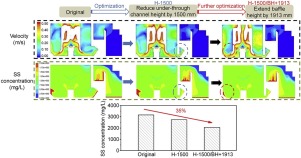当前位置:
X-MOL 学术
›
Biochem. Eng. J.
›
论文详情
Our official English website, www.x-mol.net, welcomes your
feedback! (Note: you will need to create a separate account there.)
The optimization on distributions of flow field and suspended solids in a full-scale high-rate clarifier using computational fluid dynamics
Biochemical Engineering Journal ( IF 3.7 ) Pub Date : 2020-03-01 , DOI: 10.1016/j.bej.2020.107489 Qi Xu , Keke Xiao , Qiongxiang Wu , Hui Wang , Sha Liang , Wenbo Yu , Shuangyi Tao , Huijie Hou , Bingchuan Liu , Jingping Hu , Jiakuan Yang
Biochemical Engineering Journal ( IF 3.7 ) Pub Date : 2020-03-01 , DOI: 10.1016/j.bej.2020.107489 Qi Xu , Keke Xiao , Qiongxiang Wu , Hui Wang , Sha Liang , Wenbo Yu , Shuangyi Tao , Huijie Hou , Bingchuan Liu , Jingping Hu , Jiakuan Yang

|
Abstract Suspended solids (SS) are one of major pollutants that deteriorate water quality. The high-rate clarifier is commonly used as the tertiary treatment by coagulation to agglomerate particles, thus achieving a high SS removal and making effluents acceptable for discharge. Currently the control of average residence time in operation of high-rate clarifier is challenging: With limited residence time, the particles fail to form flocs in the mixing tank, causing inefficient solid/liquid separation; while with prolonged residence time, SS sedimentation would accumulate at the bottom of the tank. In this study, a liquid-solid two-phase computational fluid dynamics (CFD) model has been developed to simulate the distributions of flow field and SS in a high-rate clarifier. The CFD model was successfully validated against experimental results in a full-scale operation, with the normalized standard error on SS less than 1.24 %. The results showed that the height of under-through channel affected the flow field more significantly rather than its width. This study also indicated that with the height of under-through channel decreasing from 2000 to 500 mm and the height of baffle increasing from 3300 to 5213 mm, the average SS concentration at the bottom of reaction tank would decrease by 34.95 % and the average residence time would be shortened by 4.77 %, which can be helpful for prolonging dredging cycle and avoiding unnecessary dredging costs.
中文翻译:

基于计算流体动力学的全尺寸高速澄清池流场和悬浮物分布优化
摘要 悬浮物(SS)是导致水质恶化的主要污染物之一。高速澄清池通常用作三级处理,通过混凝使颗粒凝聚,从而实现高 SS 去除率并使流出物可接受排放。目前高速澄清池运行中平均停留时间的控制具有挑战性:停留时间有限,颗粒无法在混合罐中形成絮凝体,导致固/液分离效率低下;而随着停留时间的延长,SS沉淀会积聚在罐底。在这项研究中,开发了一种液固两相计算流体动力学 (CFD) 模型来模拟高速澄清池中流场和 SS 的分布。CFD 模型在全尺寸操作中通过实验结果成功验证,SS 上的归一化标准误差小于 1.24%。结果表明,下穿通道的高度对流场的影响比其宽度更显着。本研究还表明,随着下通槽高度由2000mm降低至500mm,挡板高度由3300mm增加至5213mm,反应槽底部SS平均浓度降低34.95%,平均停留时间时间缩短4.77%,有助于延长疏浚周期,避免不必要的疏浚成本。结果表明,下穿通道的高度对流场的影响比其宽度更显着。研究还表明,随着下通槽高度由2000mm降低至500mm,挡板高度由3300mm增加至5213mm,反应槽底部SS平均浓度降低34.95%,平均停留时间时间缩短4.77%,有利于延长疏浚周期,避免不必要的疏浚成本。结果表明,下穿通道的高度对流场的影响比其宽度更显着。研究还表明,随着下通槽高度由2000mm降低至500mm,挡板高度由3300mm增加至5213mm,反应槽底部SS平均浓度降低34.95%,平均停留时间时间缩短4.77%,有利于延长疏浚周期,避免不必要的疏浚成本。
更新日期:2020-03-01
中文翻译:

基于计算流体动力学的全尺寸高速澄清池流场和悬浮物分布优化
摘要 悬浮物(SS)是导致水质恶化的主要污染物之一。高速澄清池通常用作三级处理,通过混凝使颗粒凝聚,从而实现高 SS 去除率并使流出物可接受排放。目前高速澄清池运行中平均停留时间的控制具有挑战性:停留时间有限,颗粒无法在混合罐中形成絮凝体,导致固/液分离效率低下;而随着停留时间的延长,SS沉淀会积聚在罐底。在这项研究中,开发了一种液固两相计算流体动力学 (CFD) 模型来模拟高速澄清池中流场和 SS 的分布。CFD 模型在全尺寸操作中通过实验结果成功验证,SS 上的归一化标准误差小于 1.24%。结果表明,下穿通道的高度对流场的影响比其宽度更显着。本研究还表明,随着下通槽高度由2000mm降低至500mm,挡板高度由3300mm增加至5213mm,反应槽底部SS平均浓度降低34.95%,平均停留时间时间缩短4.77%,有助于延长疏浚周期,避免不必要的疏浚成本。结果表明,下穿通道的高度对流场的影响比其宽度更显着。研究还表明,随着下通槽高度由2000mm降低至500mm,挡板高度由3300mm增加至5213mm,反应槽底部SS平均浓度降低34.95%,平均停留时间时间缩短4.77%,有利于延长疏浚周期,避免不必要的疏浚成本。结果表明,下穿通道的高度对流场的影响比其宽度更显着。研究还表明,随着下通槽高度由2000mm降低至500mm,挡板高度由3300mm增加至5213mm,反应槽底部SS平均浓度降低34.95%,平均停留时间时间缩短4.77%,有利于延长疏浚周期,避免不必要的疏浚成本。











































 京公网安备 11010802027423号
京公网安备 11010802027423号